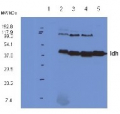1

Anti-GDC-H | H protein of glycine decarboxylase complex (GDC)
AS05 074 | Clonality: Polyclonal | Host: Rabbit | Reactivity: A. thaliana,P.hybrida cv. Mitchell, P. grandiflora, S. oleracea, T. aestivum, V. faba | cellular [compartment marker] of mitochondrial matrix
- Product Info
-
Immunogen: Purified GDC-H protein from Spinacia oleracea
Host: Rabbit Clonality: Polyclonal Purity: Total IgG. Protein G purified in PBS pH 7.4. Format: Lyophilized Quantity: 200 µg Reconstitution: For reconstitution add 200 µl of sterile water Storage: Store lyophilized/reconstituted at -20°C; once reconstituted make aliquots to avoid repeated freeze-thaw cycles. Please remember to spin the tubes briefly prior to opening them to avoid any losses that might occur from material adhering to the cap or sides of the tube. Tested applications: expansion microscopy (ExM), Tissue printing (TP), Western blot (WB) Recommended dilution: 1: 250 (ExM), 1 : 5 000 (TP), (WB) Expected | apparent MW: 16 kDa
- Reactivity
-
Confirmed reactivity: Arabidopsis thaliana, Cyanthobasis fruticulosa, Petrosimonia nigdeensis, Petunia hybrida cv. Mitchell, Portulaca grandiflora, Salsola grandis, Salsola tragus, Spinacia oleracea, Triticum aestivum, Vicia faba
Predicted reactivity: higher plants Not reactive in: No confirmed exceptions from predicted reactivity are currently known - Application Examples
-
Application example
15 µg of total protein from Arabidopsis thaliana leaf extract has been loaded per lane. Primary antibody has been used in 1: 5000 dilution using chemiluminescent detection.
Courtesy of Dr Olivier Keech, UPSC, Umeå, Sweden - Additional Information
-
Additional information: Cellular [compartment marker] of mitochondrial matrix Additional information (application): This antibody can be used on total cell extract of Arabidopsis thaliana. - Background
-
Background: The Glycine decarboxylase complex (GDC) is abundant in mitochondria matrix of C3 leaves and functions in photorespiratory carbon recovery. GDC enzyme can account for up to 50% of matrix protein, and is responsible for the most prominent metabolic activity in the mitochondria of illuminated leaves, photorespiration. GDC is a multienzyme complex composed of four component enzymes, the P-, H-, T-, and L-proteins and is responsible for the conversion of glycine produced in the peroxisome to serine in the mitochondria during photorespiratory cycle. The H-protein plays a key role as a mobile substrate that commutes between the other subunits, allowing its lipoic acid “arm” to visit the active sites of the other three components.
- Product Citations
-
Selected references: Boussardon C, Carrie C, Keech O. Comparing plastid proteomes points towards a higher plastidial redox turnover in vascular tissues than in mesophyll cells. J Exp Bot. 2023 Apr 7:erad133. doi: 10.1093/jxb/erad133.
Rohricht et al. (2023) Mitochondrial ferredoxin-like is essential for forming complex I-containing supercomplexes in Arabidopsis [published online ahead of print, 2023 Jan 25]. Plant Physiol. 2023;kiad040. doi:10.1093/plphys/kiad040
Skalický et al. (2023). Fluorescence-activated multi-organelle mapping of subcellular plant hormone distribution. Plant J. 2023 Dec;116(6):1825-1841.doi: 10.1111/tpj.16456. Epub 2023 Sep 8.
Xi et al.(2023). High CO2 facilitates fatty acid biosynthesis and mitigates cellular oxidative stress caused by CAC2 dysfunction in Arabidopsis. Plant J. 2023 Sep;115(5):1316-1330.doi: 10.1111/tpj.16321. Epub 2023 Jun 15.
Schäfer et al. (2021) Assessment of Mitochondrial Protein Topology and Membrane Insertion. Methods Mol Biol. 2022;2363:165-181. doi: 10.1007/978-1-0716-1653-6_13. PMID: 34545493.
Przybyla-Toscano et al. (2021) Protein lipoylation in mitochondria requires Fe-S cluster assembly factors NFU4 and NFU5. Plant Physiol. 2021 Oct 28:kiab501. doi: 10.1093/plphys/kiab501. Epub ahead of print. PMID: 34718778.
Guralnick et al. (2020). The Development of Crassulacean Acid Metabolism (CAM) Photosynthesis in Cotyledons of the C4 Species, Portulaca grandiflora (Portulacaceae). Plants (Basel). 2020 Jan 2;9(1). pii: E55. doi: 10.3390/plants9010055. (tissue printing)
Réthoré et al. (2019). Arabidopsis seedlings display a remarkable resilience under severe mineral starvation using their metabolic plasticity to remain self-sufficient for weeks. Plant J. 2019 Mar 22. doi: 10.1111/tpj.14325.
Lynch et al. (2017). Multifaceted plant responses to circumvent Phe hyperaccumulation by downregulation of flux through the shikimate pathway and by vacuolar Phe sequestration. Plant J. 2017 Dec;92(5):939-950. doi: 10.1111/tpj.13730. (Petunia hybrida cv. Mitchell)
Bancel et al. (2015). Proteomic Approach to Identify Nuclear Proteins in Wheat Grain. J Proteome Res. 2015 Sep 8.
Long et al. (2015). Contributions of photosynthetic and non-photosynthetic cell types to leaf respiration in Vicia faba L. and their responses to growth temperature. Plant Cell Environ. 2015 Apr 1. doi: 10.1111/pce.12544.
Cordoba-Canero et al. (2011). Arabidopsis ARP endonuclease functions in a branched base excision DNA repair pathway completed by LIG1. The Plant J in print. - Protocols
-
Agrisera Western Blot protocol and video tutorials
Protocols to work with plant and algal protein extracts - Reviews:
-
Michal RUREK | 2014-02-1410 µg of mitochondrial proteins from cauliflower (Brassica oleracea var. botrytis) curds (apical layer) was separated on 12 % SDS-PAGE (Laemmli- type) and blotted 1h to Immobilone P (Millipore) using Sedryt apparatus (Kucharczyk). After blocking (5% milk in PBS-T) for 1 h at RT, blots were incubated in the primary antibody at a dilution of 1: 5000 for overnight at 4 deg. with agitation. The primary antibody, diluted in 2% milk in PBS-T was reused several times. Secondary, anti-rabbit HRP- linked antibodies were bound at 1/10000 dilution at RT (1h). Main band of ca. 15 kDa was detected using standart GE Healthcare ECL reagents.
Accessories

AS06 203A | Clonality: Polyclonal | Host: Rabbit | Reactivity: A. thaliana, C.annuum, G. max, L. esculentum, O. sativa, P. sativum, S. tuberosum, Z. mays | cellular [compartment marker] of mitochondrial matrix

AS07 212 | Clonality: Polyclonal | Host: Rabbit | Reactivity: A. thaliana, A. palmeri, S. oleracea, di and monocots | Cellular [compartment marker] of mitochondrial outer membrane

